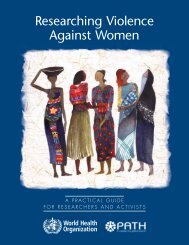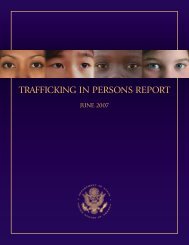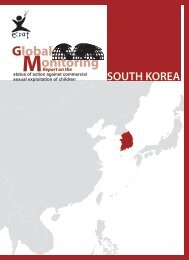Download PDF - Violence Against Children - East Asia and the ...
Download PDF - Violence Against Children - East Asia and the ...
Download PDF - Violence Against Children - East Asia and the ...
Create successful ePaper yourself
Turn your PDF publications into a flip-book with our unique Google optimized e-Paper software.
Indonesia<br />
• The BPS also estimated that 23% of<br />
domestic workers in all of Indonesia are<br />
aged between 10 <strong>and</strong> 18.<br />
• A census in 1999 found that 30% of girls<br />
<strong>and</strong> young women aged 10–24 in Java,<br />
West Sumatra <strong>and</strong> <strong>East</strong> Kalimantan had a<br />
first marriage at age 16 or younger.<br />
<strong>Against</strong> this complex background, agencies<br />
work to promote child protection in practice.<br />
The need for increased access to quality<br />
education emerged many times in <strong>the</strong> course<br />
of this Indonesia study. Communities <strong>and</strong><br />
families express this as a priority for <strong>the</strong>ir<br />
children. It is seen as bringing benefit in <strong>the</strong><br />
immediate <strong>and</strong> longer term, <strong>and</strong> as a<br />
resource against factors such as economic<br />
downturn or political or ethnic tension.<br />
<strong>Children</strong> <strong>the</strong>mselves want to build <strong>the</strong>ir<br />
options through education.<br />
The Government of Indonesia has<br />
committed itself to implementing <strong>the</strong> UN<br />
Convention on <strong>the</strong> Rights of <strong>the</strong> Child (CRC),<br />
which it ratified on 25 August 1990. A<br />
National CRC Coordinating Agency within<br />
<strong>the</strong> Ministry for People’s Welfare is<br />
responsible for coordinating <strong>the</strong><br />
implementation. 2 In addition, <strong>the</strong> National<br />
Government under <strong>the</strong> current President has<br />
been encouraging Provincial governments to<br />
develop social protection policies, which will<br />
include child protection issues.<br />
Access to education<br />
Each year, <strong>the</strong>re are about a million<br />
Indonesian children aged 7–12 years not<br />
enrolled in primary school. Of those who do<br />
enrol, nearly one million drop out before<br />
completing <strong>the</strong> primary cycle. The proportion<br />
of Indonesian children entering first grade of<br />
primary school who eventually reached grade<br />
5 was about 83% in 2000. In <strong>the</strong> age group<br />
13–15 years, some six million children never<br />
enrol in junior secondary school – <strong>the</strong> three<br />
additional years required for compulsory<br />
basic education. Of those that do, some<br />
200,000 drop out before completing.<br />
This means that <strong>the</strong>re are at least seven<br />
million children in <strong>the</strong> age group 7–15 years<br />
who are ei<strong>the</strong>r out of school, or have never<br />
been to school. These children come mostly<br />
from poorer groups, <strong>and</strong> allowing <strong>the</strong>m to<br />
drop out means a perpetuation of <strong>the</strong><br />
poverty cycle, as well as acceptance of<br />
system inefficiency.<br />
These are also <strong>the</strong> children who are more<br />
vulnerable to child labour <strong>and</strong> exploitation.<br />
One report estimates a third of all registered<br />
<strong>and</strong> unregistered commercial sex workers<br />
(between 40,000 <strong>and</strong> 70,000) in Indonesia to<br />
be under 18 years old. A 1999 survey by <strong>the</strong><br />
Department of Social Affairs registered about<br />
40,000 street children in 12 major cities<br />
across Indonesia. Most of <strong>the</strong>se children go<br />
home to <strong>the</strong>ir families, but some 4–7% are<br />
homeless <strong>and</strong> actually live on <strong>the</strong> streets,<br />
vulnerable to abuse, disease <strong>and</strong> exploitation.<br />
Government spending on education listed<br />
for 1997 is only 1.4 % of GDP. In 2000<br />
(<strong>the</strong> most recent figures available), <strong>the</strong><br />
estimated enrolment rate for primary<br />
education is 95%. This drops to 47% for<br />
secondary school. 3<br />
An integrated approach<br />
One area of child protection practice<br />
common to Government, United Nations<br />
Agencies <strong>and</strong> World Vision strategies in<br />
Indonesia is that of promoting access to<br />
education, <strong>and</strong> school retention, for children<br />
at risk. Part of this strategy is <strong>the</strong> scaling-up<br />
of successful practice. Collaboration between<br />
<strong>the</strong> Ministry of Education, two Universities<br />
<strong>and</strong> World Vision has led to <strong>the</strong> development<br />
of a four-year program that is addressing <strong>the</strong><br />
issue of access, retention <strong>and</strong> capacity, as well<br />
as ensuring that child rights are fur<strong>the</strong>r<br />
integrated into teaching practice.<br />
As World Vision’s child abuse <strong>and</strong> neglect<br />
(CAN) study 4 emphasised, education has a<br />
key role not only in increasing <strong>the</strong> life options<br />
of <strong>the</strong> child, but also in involving parents<br />
more fully in <strong>the</strong> development of <strong>the</strong>ir<br />
2<br />
Source: Indonesia Country Profile, update, UNICEF, February 2002<br />
3<br />
Central Bureau of Statistics (BPS), 2001<br />
4<br />
Dorning, K, Crying Out: <strong>Children</strong> <strong>and</strong> communities speak on abuse <strong>and</strong> neglect, World Vision International, 2002 (http://www.wvi.org/imagine/can.htm)<br />
46

















